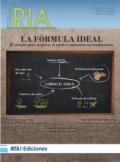Ver ítem
- xmlui.general.dspace_homeCentros Regionales y EEAsCentro Regional Santa FeEEA RafaelaArtículos científicosxmlui.ArtifactBrowser.ItemViewer.trail
- Inicio
- Centros Regionales y EEAs
- Centro Regional Santa Fe
- EEA Rafaela
- Artículos científicos
- Ver ítem
Manejo sustentable de sistemas agrícolas en la región central de Córdoba: una experiencia de largo plazo en INTA EEA Manfredi
Resumen
La principal limitante ambiental para la agricultura de secano en la región central de Córdoba es la disponibilidad hídrica, por lo que toda práctica de manejo que favorezca la captación, almacenamiento y conservación del agua en el suelo redundará en productividades y rendimientos más elevados de los cultivos. En un ensayo de larga duración sobre un suelo Haplustol del centro de la provincia de Córdoba (EEA INTA Manfredi) se evaluó el efecto de
[ver mas...]
La principal limitante ambiental para la agricultura de secano en la región central de Córdoba es la disponibilidad hídrica, por lo que toda práctica de manejo que favorezca la captación, almacenamiento y conservación del agua en el suelo redundará en productividades y rendimientos más elevados de los cultivos. En un ensayo de larga duración sobre un suelo Haplustol del centro de la provincia de Córdoba (EEA INTA Manfredi) se evaluó el efecto de diferentes sistemas de labranza y secuencias de cultivo sobre el rendimiento de soja y maíz, el agua útil inicial, el aporte de residuos y el stock de carbono. El rendimiento de soja para el periodo 1997 a 2014 fue en siembra directa en la rotación soja-maíz (SM-SD) y el menor fue en labranza reducida en monocultivo (SS-LR) con diferencias significativas entre tratamientos. El rendimiento de maíz fue significativamente más elevado (p<0,05) en siembra directa (SD) que en labranza reducida (LR) y en siembra directa con cultivo de cobertura (SDcc), no difiriendo estos dos últimos sistemas entre sí. El agua útil inicial a la siembra de soja fue significativamente mayor en los tratamientos de siembra directa con gramíneas en la secuencia (SM-SDcc, SM-SD y SS-SDcc). El stock de carbono también mostró diferencias significativas entre tratamientos,siendo mayor en siembra directa en la secuencia SM (SM-SD y SM-SDcc). Estos resultados permitieron comprobar que en la región central de Córdoba la siembra directa es un sistema de manejo que contribuye a aumentar los rendimientos de los cultivos y el stock de carbono del suelo, lo cual se asocia con la mejora en la condición hídrica del suelo.
[Cerrar]
The main environmental limiting factor for rainfed agriculture in the central region of Cordoba is water availability, so that any management practice promoting soil water captation, storage and conservation will result in higher crop productivity and yields of the soil-crop system. A long term field trial on a Haplustoll soil in the center of Córdoba province was sampled to evaluate the effect of different tillage and crop sequence systems on soybean and
[ver mas...]
The main environmental limiting factor for rainfed agriculture in the central region of Cordoba is water availability, so that any management practice promoting soil water captation, storage and conservation will result in higher crop productivity and yields of the soil-crop system. A long term field trial on a Haplustoll soil in the center of Córdoba province was sampled to evaluate the effect of different tillage and crop sequence systems on soybean and maize yields, initial available soil water, crop residues and soil carbon stocks. Mean soybean yields for the 1997-2014 period was significantly higher under no-tillage with soybean-corn sequence, and lower under monocropping and reduced tillage. Maize yield was significantly higher under no-tillage (SD) than under reduced tillage (LR) and under no-tillage with cover crop (SDcc), with no differences between the last. Under soybean initial soil available water was significantly higher in no-tillage treatments including grasses in crop sequences (SM-SDcc, SM-SD and SS-SDcc). The carbon stock was significantly higher under no-tillage and the SM sequence (SM-SD and SM-SDcc). Results show that in the central region of Cordoba no-tillage contributes to increase crop yields and soil carbon stock, which is associated to a better soil water condition.
[Cerrar]

Fuente
RIA, 41 (2) : 215-222
Fecha
2015-08
Editorial
Gerencia de Comunicación e Imagen Institucional, DNA SICC, INTA
Formato
pdf
Tipo de documento
article
Palabras Claves
Derechos de acceso
Abierto
 Excepto donde se diga explicitamente, este item se publica bajo la siguiente descripción: Creative Commons Attribution-NonCommercial-ShareAlike 2.5 Unported (CC BY-NC-SA 2.5)
Excepto donde se diga explicitamente, este item se publica bajo la siguiente descripción: Creative Commons Attribution-NonCommercial-ShareAlike 2.5 Unported (CC BY-NC-SA 2.5)


